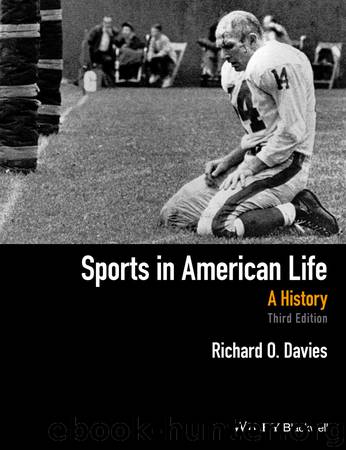Sports in American Life by Richard O. Davies

Author:Richard O. Davies
Language: eng
Format: epub
ISBN: 9781118912379
Publisher: Wiley
Published: 2016-07-18T00:00:00+00:00
Emphasis and De-emphasis
Although much of public scrutiny was directed at major college basketball and football, in fact the NCAA was becoming a diverse organization that embraced a wide variety of missions. The great majority of the members of the NCAA were small institutions that fielded a variety of teams with no pretensions of athletic grandeur. In 1973, the NCAA created a three-tiered grouping of schools. Division III contained several hundred small colleges that offered no athletic scholarships, Division II schools offered a restricted number of athletic grants-in-aid, and only Division I schools – the so-called big-time programs – were permitted to provide “full-ride” grants-in-aid to a much larger number of athletes. In 1978 a category for football only was created within Division I, with the designation of a Division I-AA that permitted schools to fund a maximum of 65 scholarships and compete in a 16-team playoff to determine the national championship. These schools would, however, compete at the Division I level in all other sports.
The primary focus of intercollegiate athletics was on big-time football. The cost of operating a Division I football program was very expensive, and as a consequence, by 1960 more than 60 institutions had either dropped the sport altogether or opted to slash budgets and play a modest schedule. The flurry of canceled programs by institutions that had once been so prominent in football, such as Carnegie Tech, Washington University, and Western Reserve, was reason for concern among football enthusiasts. A large number of private urban Catholic universities were among those leading this movement. The University of San Francisco stunned the football world when it dropped the sport on the heels of an undefeated, untied, 10th-ranked season in 1951. The winning season had also produced a large deficit. The most prominent university to drop football during this period was Georgetown University, which in the late 1930s had won 43 consecutive games. Its president cited football's lack of educational value in an article in the Saturday Evening Post, commenting that the sport provided nothing beneficial for the academic mission of the university. Other Catholic institutions followed suit, among them St Bonaventure, Duquesne, Villanova, Fordham, Detroit, Xavier (of Cincinnati), and Marquette.
The most significant change in football occurred ironically on the campuses where the sport had originated. One-time football giants Yale, Princeton, and Harvard decided to end any pretensions of competing for national football honors. These private institutions had long resisted granting control over their campus programs to an athletic conference. In 1945, eight elite eastern institutions signed the first Ivy Group Accord, which emphasized unsubsidized football and the maintenance of high academic standards for athletes. Between 1952 and 1956, the Ivy Group formalized itself into the Ivy League and adopted policies aimed directly at eliminating the excesses of big-time football. The league's membership included Princeton, Columbia, Yale, Dartmouth, Harvard, Brown, Cornell, and Pennsylvania. For starters, the new league banned spring practice. Off-campus recruiting was sharply curtailed and the practice of alumni or boosters paying for an athlete's college expenses was eliminated.
Download
This site does not store any files on its server. We only index and link to content provided by other sites. Please contact the content providers to delete copyright contents if any and email us, we'll remove relevant links or contents immediately.
Unstoppable by Maria Sharapova(3118)
The Inner Game of Tennis by W. Timothy Gallwey(2990)
Urban Outlaw by Magnus Walker(2950)
Crazy Is My Superpower by A.J. Mendez Brooks(2860)
The Social Psychology of Inequality by Unknown(2311)
The Fight by Norman Mailer(2159)
Unstoppable: My Life So Far by Maria Sharapova(2128)
Going Long by Editors of Runner's World(1921)
Accepted by Pat Patterson(1917)
Motorcycle Man by Kristen Ashley(1862)
The Sports Gene: Inside the Science of Extraordinary Athletic Performance by David Epstein(1822)
The Happy Runner by David Roche(1821)
Backpacker the Complete Guide to Backpacking by Backpacker Magazine(1815)
Sea Survival Handbook by Keith Colwell(1796)
Futebol by Alex Bellos(1785)
Mind Fuck by Manna Francis(1744)
Peak: Secrets from the New Science of Expertise by Anders Ericsson & Robert Pool(1662)
Endure by Alex Hutchinson(1605)
The Call of Everest by Conrad Anker(1550)
